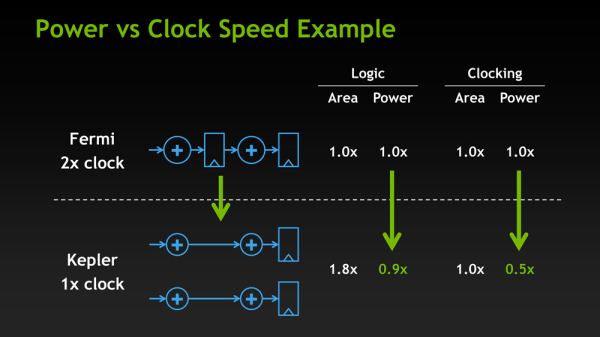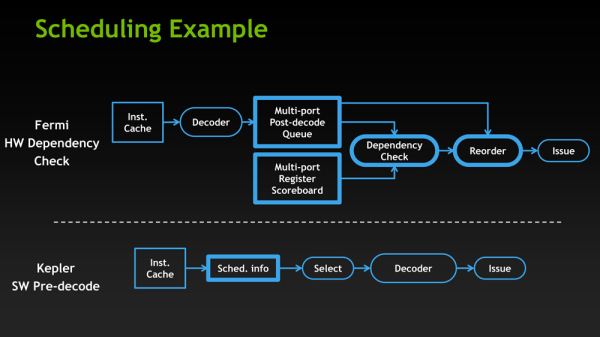NVIDIA GeForce GTX 680 Review: Retaking The Performance Crown
by Ryan Smith on March 22, 2012 9:00 AM ESTThe Kepler Architecture: Efficiency & Scheduling
So far we’ve covered how NVIDIA has improved upon Fermi for; now let’s talk about why.
Mentioned quickly in our introduction, NVIDIA’s big push with Kepler is efficiency. Of course Kepler needs to be faster (it always needs to be faster), but at the same time the market is making a gradual shift towards higher efficiency products. On the desktop side of matters GPUs have more or less reached their limits as far as total power consumption goes, while in the mobile space products such as Ultrabooks demand GPUs that can match the low power consumption and heat dissipation levels these devices were built around. And while strictly speaking NVIDIA’s GPUs haven’t been inefficient, AMD has held an edge on performance per mm2 for quite some time, so there’s clear room for improvement.
In keeping with that ideal, for Kepler NVIDIA has chosen to focus on ways they can improve Fermi’s efficiency. As NVIDIA's VP of GPU Engineering, Jonah Alben puts it, “[we’ve] already built it, now let's build it better.”
There are numerous small changes in Kepler that reflect that goal, but of course the biggest change there was the removal of the shader clock in favor of wider functional units in order to execute a whole warp over a single clock cycle. The rationale for which is actually rather straightforward: a shader clock made sense when clockspeeds were low and die space was at a premium, but now with increasingly small fabrication processes this has flipped. As we have become familiar with in the CPU space over the last decade, higher clockspeeds become increasingly expensive until you reach a point where they’re too expensive – a point where just distributing that clock takes a fair bit of power on its own, not to mention the difficulty and expense of building functional units that will operate at those speeds.
With Kepler the cost of having a shader clock has finally become too much, leading NVIDIA to make the shift to a single clock. By NVIDIA’s own numbers, Kepler’s design shift saves power even if NVIDIA has to operate functional units that are twice as large. 2 Kepler CUDA cores consume 90% of the power of a single Fermi CUDA core, while the reduction in power consumption for the clock itself is far more dramatic, with clock power consumption having been reduced by 50%.
Of course as NVIDIA’s own slide clearly points out, this is a true tradeoff. NVIDIA gains on power efficiency, but they lose on area efficiency as 2 Kepler CUDA cores take up more space than a single Fermi CUDA core even though the individual Kepler CUDA cores are smaller. So how did NVIDIA pay for their new die size penalty?
Obviously 28nm plays a significant part of that, but even then the reduction in feature size from moving to TSMC’s 28nm process is less than 50%; this isn’t enough to pack 1536 CUDA cores into less space than what previously held 384. As it turns out not only did NVIDIA need to work on power efficiency to make Kepler work, but they needed to work on area efficiency. There are a few small design choices that save space, such as using 8 SMXes instead of 16 smaller SMXes, but along with dropping the shader clock NVIDIA made one other change to improve both power and area efficiency: scheduling.
GF114, owing to its heritage as a compute GPU, had a rather complex scheduler. Fermi GPUs not only did basic scheduling in hardware such as register scoreboarding (keeping track of warps waiting on memory accesses and other long latency operations) and choosing the next warp from the pool to execute, but Fermi was also responsible for scheduling instructions within the warps themselves. While hardware scheduling of this nature is not difficult, it is relatively expensive on both a power and area efficiency basis as it requires implementing a complex hardware block to do dependency checking and prevent other types of data hazards. And since GK104 was to have 32 of these complex hardware schedulers, the scheduling system was reevaluated based on area and power efficiency, and eventually stripped down.
The end result is an interesting one, if only because by conventional standards it’s going in reverse. With GK104 NVIDIA is going back to static scheduling. Traditionally, processors have started with static scheduling and then moved to hardware scheduling as both software and hardware complexity has increased. Hardware instruction scheduling allows the processor to schedule instructions in the most efficient manner in real time as conditions permit, as opposed to strictly following the order of the code itself regardless of the code’s efficiency. This in turn improves the performance of the processor.
However based on their own internal research and simulations, in their search for efficiency NVIDIA found that hardware scheduling was consuming a fair bit of power and area for few benefits. In particular, since Kepler’s math pipeline has a fixed latency, hardware scheduling of the instruction inside of a warp was redundant since the compiler already knew the latency of each math instruction it issued. So NVIDIA has replaced Fermi’s complex scheduler with a far simpler scheduler that still uses scoreboarding and other methods for inter-warp scheduling, but moves the scheduling of instructions in a warp into NVIDIA’s compiler. In essence it’s a return to static scheduling.
Ultimately it remains to be seen just what the impact of this move will be. Hardware scheduling makes all the sense in the world for complex compute applications, which is a big reason why Fermi had hardware scheduling in the first place, and for that matter why AMD moved to hardware scheduling with GCN. At the same time however when it comes to graphics workloads even complex shader programs are simple relative to complex compute applications, so it’s not at all clear that this will have a significant impact on graphics performance, and indeed if it did have a significant impact on graphics performance we can’t imagine NVIDIA would go this way.
What is clear at this time though is that NVIDIA is pitching GTX 680 specifically for consumer graphics while downplaying compute, which says a lot right there. Given their call for efficiency and how some of Fermi’s compute capabilities were already stripped for GF114, this does read like an attempt to further strip compute capabilities from their consumer GPUs in order to boost efficiency. Amusingly, whereas AMD seems to have moved closer to Fermi with GCN by adding compute performance, NVIDIA seems to have moved closer to Cayman with Kepler by taking it away.
With that said, in discussing Kepler with NVIDIA’s Jonah Alben, one thing that was made clear is that NVIDIA does consider this the better way to go. They’re pleased with the performance and efficiency they’re getting out of software scheduling, going so far to say that had they known what they know now about software versus hardware scheduling, they would have done Fermi differently. But whether this only applies to consumer GPUs or if it will apply to Big Kepler too remains to be seen.












404 Comments
View All Comments
CeriseCogburn - Sunday, March 25, 2012 - link
They get to show amd "catching up" so they like it. They get to try to puke out Kepler's 2G ram and make amd's 3G shine, so they "can't resist" - and when frame rates fall below playable, "they all of a sudden" "don't care", even when the puking attempt fails. They haven't been able to resist since the 580 w 1.5G vs 2G 6950/6970 it was a great blame the low ram game for any changes.Then they checked 6950 1G 2G and 2G was slower...but so what.
Now 2G Kepler has put the ram lie to rest even in triple monitor gaming... but any lesser win or loss or slimming margin can still be blamed on that, it gets people "buying the amd card" and they get real frustrated here when they can't figure out why Nvidia is winning when they don't believe it should be. It's always expressed in the article how shocked they are. So ram is a convenient scapegoat. It's always used a "future proofing" notion as well, though no evidence has ever surfaced for that.
_vor_ - Sunday, March 25, 2012 - link
What's with all the nerdrage? Do you work for NVIDIA?formulav8 - Sunday, March 25, 2012 - link
Get over yourself already. NVidia doesn't even like You. Can't believe how people feel about a stinking stupid corporation.CeriseCogburn - Tuesday, March 27, 2012 - link
It's not about a corporation it's about facts guy. Facts mean my friends and my readers get the best they can get for the buck they are paying.Just because amd is behind and therefore lies are told, does not mean the truth should not shine through !
The truth shall shine through !
AnnonymousCoward - Sunday, March 25, 2012 - link
Personally, I don't care if the card has 64kB of RAM. Or 8 million stream processors. Performance, cost, power, and noise are what matter.And back to my point: performance in the 20-50fps range at 2560x1600 4xAA is meaningless and not a criteria for judgment.
CeriseCogburn - Tuesday, March 27, 2012 - link
I never disagreed with that point I merely explained why things are done in such and such a way while ignoring other things.It's not difficult at all.
Zephyr66z0r - Sunday, March 25, 2012 - link
Well I understand 'some' of the tech behind the GTX680 one thing stands out. 256bit bus width, when you see that with nvidia its along the lines of GTX560.... so does that mean there's going be a 384bit (mid-high) or 512bit(high-enth, 256bit + 256bit + 2 GPU) card/s coming out?I can't wait, anyone done SLi with it yet?
dmnwlv - Sunday, March 25, 2012 - link
First off, I think nVidia has done a good job with the new GTX680.However I do not need a game that is already running at 100+ frames to be even faster.
It needs to be fast at where it counts - games that are still running slow at 60 fps and below.
For this, of 3 relevant games, nVidia is faster at just one of them. Experience (if you also remember) has shown that the results could be very different once frames for some settings/games hit below 60fps.
Hence I cannot agree with all the big f about GTX680 is so much faster fuss.
You guys are led by the heart (much alike ati fanboys you used to call) than the brain.
And all other compute tests are non-relevant to me (and majority of you to be honest).
gramboh - Monday, March 26, 2012 - link
What about a little game (that several million people play) called Battlefield 3? NV has a massive lead with the GTX 680 over the 7970/7950. AT only benches single player, but the game is even more punishing in 64 player multiplayer. Having a smooth framerate at max detail with 4X AA/16X AF is a big competitive advantage and makes the game significantly more enjoyable.Kind of disappointed the card isn't faster in Witcher 2, which I think has the best graphics of a single player game.
CeriseCogburn - Tuesday, March 27, 2012 - link
Have all of you people repeating that FUD forgotten Shogun 2 Total War ?It's the hardest game in the bench set according to anandtech...
How is it that THE HARDEST GAME that Nvidia swept top to bottom at every resolution is suddenly and completely forgotten about, while we hear these other FUD declarations ?
How does that work, just repeat what some other mistaken fudder spewed ?